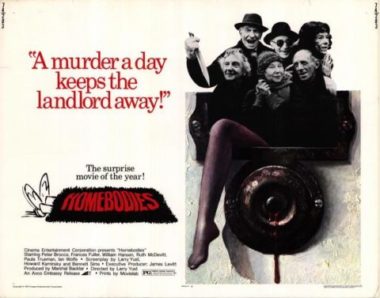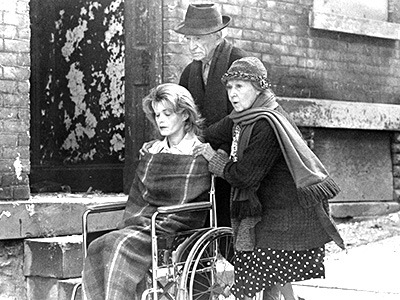Geezer horror? If there is such a thing then HOMEBODIES is easily the finest example of such, a wildly entertaining lark about old people on a killing spree that’s funny, stylish and, finally, deeply menacing.
…funny, stylish and, finally, deeply menacing.
Old people were a frequent source of terror in horror/exploitation movies during the early seventies, of which HOMEBODIES, released in 1974, is a prime example (others include the Peter Walker Britsploiter’s FRIGHTMARE and HOUSE OF WHIPCORD).
The basic premise of HOMEBODIES—geezers desperate to stay in a condemned apartment building—should be familiar to many of you, as it’s essentially identical to that of the Steven Spielberg produced comedy BATTERIES NOT INCLUDED (1987). In tone, however, the two films couldn’t be more different, as HOMEBODIES forsakes the mawkishness of that film as well as the grindhouse scuzziness of the abovementioned Peter Walker flicks.
Old people were a frequent source of terror in horror/exploitation movies during the early seventies…
HOMEBODIES may be exploitation, but it’s done with a degree of skill uncommon in or out of the exploitation arena, and features an impressive cast of veteran character actors, including Ian Wolfe, a reliable film presence since the thirties (in films ranging from the Val Lewton production BEDLAM to George Lucas’s THX-1138) and Ruth McDevitt, who may be familiar from her appearances in THE BIRDS and KOLACHAK, THE NIGHT STALKER. Also look for Kenneth Tobey in a small role, a genre legend in films like the original THING, THE BEAST FROM 20,000 FATHOMS, THE HOWLING and countless others.
An old building in the midst of downtown Cincinnati has been slated for demolition. Miss Pollack, an attractive young woman employed by the city, arrives at the site to give notice to the building’s last remaining residents, a motley group of six seventysomethings. Their reaction to Miss Pollack’s presence is hostile and the geezers bodily throw her out. The city retaliates by turning off the building’s gas and electricity, which only gives the old folks inside, led by the controlling Mattie and her best friend Miss Emily—who spends her days chatting with her long dead husband and refuses to leave her apartment room—a new-found sense of community.
…a deeply assured, fully realized piece of work that’s both grim and darkly funny in equal measure.
Several of the workmen set to demolish the building meet with suspicious accidents at a nearby construction site: a snapped wire plunges one man to his death and faulty wiring electrocutes three others. Could our lovable protagonists be involved? It certainly seems that way, especially since the ever-watchful Mattie is at the sight of both incidents, intently viewing everything that occurs.
Not long after this Miss Pollack returns with the police and forcibly hustles the condemned building’s residents off to an old folks’ home. She only manages to nab four of them, with Mattie and Miss Emily staying behind. Miss Pollack comes back to collect the two holdouts and Miss Emily stabs her to death with a butcher knife.
The performances are uniformly excellent, particularly that of 74-year-old Paula Trueman, who’s both scary and loveable as Mattie, the ringleader of the mayhem.
Emboldened, the deadly sextuplet (the four who were hustled off to the old folks’ home having promptly made their way back) set their sights on the construction foreman, tying him up and encasing him in cement. Another construction worker meets his end when one of our “heroes” hijacks a wrecking ball and brings it down on the port-a-potty where the unfortunate worker happens to be.
With so much killing going on, dissention among the homicidal over-the-hill gang is inevitable. One of them, the morally upstanding Mrs. Loomis, resolves to tell the police everything, but Mattie silences her—for good—by bashing an urn containing the ashes of Miss Emily’s dead husband over Mrs. Loomis’ head. Now, it seems, the out-of-control Mattie is the problem, and will have to be got rid of by her former friends.
Director Larry Yust was not a prolific filmmaker. He’s probably best known outside HOMEBODIES for his 1973 Iceberg Slim adaptation TRICK BABY, one of his three feature films, the last of which, the forgettable comedy SAY YES, was released back in 1986. HOMEBODIES belies Yust’s limited resume, as it’s a deeply assured, fully realized piece of work that’s both grim and darkly funny in equal measure. The problems faced by the elderly are convincingly handled with great sensitivity, in scenes like the one where the protagonists push a corpse in a wheelchair down a sloped sidewalk…which, the film makes clear, is not particularly easy for frail seventysomethings! In deference to such frail characters, the atmosphere is kept quiet and stately and the pacing deliberate—not slow, mind you, just deliberate, which ideally suits the proceedings. The performances are uniformly excellent, particularly that of 74-year-old Paula Trueman, who’s both scary and loveable as Mattie, the ringleader of the mayhem.
Another plus is the script, co-written by Yust, which demonstrates real ingenuity in the gross-out bits, particularly a priceless gag involving a corpse’s foot that I know I won’t be forgetting any time soon. If there’s a weak spot, it occurs when Mattie tries to commandeer a car, which Yust overlays with annoying forced slapstick (nor does he satisfactorily explain how she so quickly arrives back at the central location after abandoning the vehicle on a bridge miles away). Otherwise, however, the film is superbly realized in every respect.
Vital Statistics
HOMEBODIES
Cinema Entertainment Corporation
Director: Larry Yust
Producer: Marshal Backlar
Screenplay: Larry Yust, Howard Kaminsky, Bennett Sims
Cinematography: Isidore Mankofsky
Editing: Peter Parasheles
Cast: Douglas Fowley, Ruth McDevitt, Frances Fuller, Ian Wolfe, William Hansen, Paula Trueman, William Benedict, Peter Brocco, John Craig, Norman Gottschalk, Michael Johnson, Wesley Lau, Linda Marsh, Eldon Quick, Kenneth Tobey


